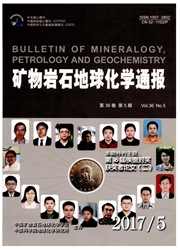

 中文摘要:
中文摘要:
本文研究了可见光下天然闪锌矿的光催化还原能力,通过可见光下天然闪锌矿对甲基橙的光催化降解实验讨论了天然闪锌矿晶格中的杂质缺陷、导带能级位置、光生空穴捕获剂和溶液pH值对可见光催化降解效率的影响。结果表明,在抗坏血酸做空穴捕获剂的条件下,经2h的可见光催化实验,甲基橙能被天然闪锌矿完全还原降解。天然闪锌矿晶格中丰富的杂质缺陷在禁带中形成杂质能级,可将闪锌矿对光的响应拓展到可见光的波长范围。与天然金红石相比,闪锌矿对甲基橙的较强光催化还原降解效果与其导带电子更负的氧化还原电势有关。此外,空穴捕获剂和pH值的选择都是影响催化效果的关键因素。天然闪锌矿在可见光催化降解污染物领域颇有应用前景。
 英文摘要:
英文摘要:
The photocatalytic reductive capability of natural sphalerite under visible light was studied in this paper. The effects of impurity defects in the crystal lattices of natural sphalerite, conduction band energy level, hole-scavenger and pH value on the efficiency of photocatalytic degradation of methyl orange by natural sphalerite under visible light have been discussed based on a series of experimental results. The results indicate that, on the condition of ascorbic acid as hole scavenger, natural sphalerite performed great photoreductive capability as the methyl orange was completely reduced by natural sphalerite under visible light irradiation after 2 hours. The impurity defects, which caused impurity bands in the bandgap, of natural sphalerite could extend its absorbing range to the visible light wavelength range. In comparison with natural futile, the higher photocatalytic reduction capability of sphalerite for the reduction of methyl orange is associated with its more negative potential of electrons in the conduction band. In addition, both of the proper hole-scavengers and pH values are the key factors influenced the photocatalytic effect. Therefore, it is believed that natural sphalerite has a promising potential for applying in the photocatalytic degradation of pollutants under the visible light.
 同期刊论文项目
同期刊论文项目
 同项目期刊论文
同项目期刊论文
 期刊信息
期刊信息
